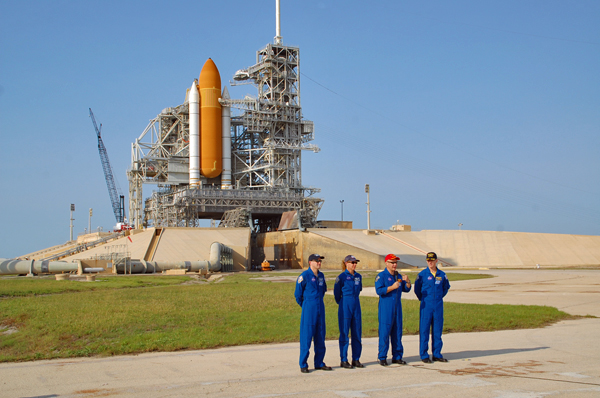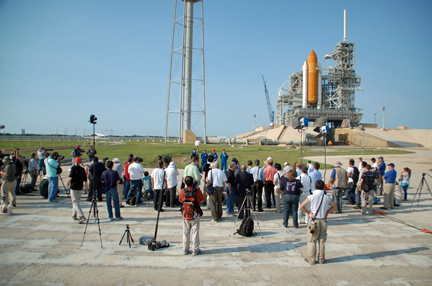External tank inspections proceeding smoothly, fuel valve replaced
By WILLIAM HARWOOD
CBS News
KENNEDY SPACE CENTER, FL--Engineers carrying out X-ray inspections of 50 rib-like "stringers" in the shuttle Atlantis' external tank are running ahead of schedule and so far, officials said Wednesday, there are no signs of any temperature-induced cracks in the wake of a fueling test last week.
Working in parallel, another team replaced a leaking hydrogen valve in main engine No. 3 on Tuesday. Reassembly and closeout should be complete by this weekend, clearing the way for tests to make sure the valve is leak free and working properly for launch July 8.
Atlantis' crew, meanwhile -- commander Christopher Ferguson, pilot Douglas Hurley, flight engineer Rex Walheim and cargo loadmaster Sandra Magnus -- is at the Kennedy Space Center this week to review launch pad emergency procedures and to participate in a dress-rehearsal countdown Thursday, a major milestone on the road to launch.
"We're very honored to be in this position," Ferguson told reporters at the base of the launch pad Wednesday. "There are many people who could be here ... so we consider ourselves fortunate. I think each of us feels a little, perhaps, extra burden to make sure we put on the best possible face forward for the last go around of this, and the crew's very prepared."
Said Magnus: "We feel very honored to be on this flight and we've been very focused to make sure that we perform it well in honor of all the people who have been involved, not just in this mission but all the missions."
"We're just the tip of the iceberg, of a huge group of people who plan, get the hardware ready and prepare our procedures and then watch over the vehicle while we're on board," she said. "And we feel very, very strongly that we have to be as prepared as possible to perform the mission to the extent that they're expecting of us. I think when it's all done, we can celebrate together, not only the mission, but the whole program."
The terminal countdown demonstration test, or TCDT, is valuable to the astronauts because "you're working with the whole team down here and actually going through a launch count right up to T-zero," Hurley said. "You've got your suit, you've got your suit techs, you're doing all the motions you go through on launch day, all the way out to the pad."
The astronauts have participated in fire training, inspected the launch pad's emergency slidewire escape system, inspected a safety bunker and practiced driving an armored personnel carrier stationed near the pad for an emergency evacuation.
The training is "invaluable," Hurley said. "You can do all the simulators in the world, but until you get in that real vehicle, touch the vehicle, see what you can reach, see the different switches, everything's just a little different when you're in the real vehicle. So it's a great way to get you ready for launch day, when it counts."
The primary goal of the 135th and final shuttle mission is to deliver 9,600 pounds of cargo and supplies to the International Space Station to support a six-person crew through 2012 as hedge against problems that might delay commercial unmanned cargo ships being built to replace lost shuttle capability. Atlantis also will deliver experimental robotic satellite refueling gear and bring back to Earth an ammonia coolant system pump that failed last year.
NASA managers plan to meet at the Kennedy Space Center next Tuesday to review Atlantis' ground processing and to set an official launch date. As of this writing, the shuttle appears on track for liftoff at 11:26:46 a.m. EDT (GMT-4) on July 8. NASA will be able to make two launch attempts in three days before standing down for the launch of an unmanned Delta 4 rocket July 14. The next shuttle launch window opens July 16 and extends through the end of the month.
An on-time launch assumes the fuel valve replacement and retest go smoothly and that no problems are found with the stringers making up the external tank's central compartment. The ribbed intertank section separates the tank's liquid hydrogen and oxygen tanks, with the upper dome of the hydrogen tank fitting into the bottom of the intertank and the lower dome of the oxygen tank fitting in the top.
During an attempt to launch the shuttle Discovery on its final flight last year, engineers discovered stress-relief cracks in several of the stringers making up the intertank.
After an exhaustive investigation, NASA determined that the lightweight aluminum-lithium alloy used to make the stringers in question came from a lot that was more susceptible to fractures than normal. When the tank was loaded with propellants, and the contraction of the oxygen tank pulled the tops of the intertank stringers inward, cracks developed.
NASA installed structural stiffeners called radius block doublers on the top few inches of the stringers to add additional strength, preventing cracks that might compromise the tank's structural integrity or cause foam insulation to pop off during ascent. Discovery's tank performed normally during the shuttle's eventual launch last February.
Because the stringers in Atlantis' tank had a similar pedigree, NASA managers ordered installation of radius block doublers and ordered a fueling test last week to subject the system to cryogenic conditions. Engineers began X-ray inspections of the stringers facing Atlantis on Monday and by Wednesday, the upper sections of the 50 stringers on the side of the tank facing Atlantis had been inspected.
"So far, they've seen nothing amiss," said a NASA spokesman.
CBS News
KENNEDY SPACE CENTER, FL--Engineers carrying out X-ray inspections of 50 rib-like "stringers" in the shuttle Atlantis' external tank are running ahead of schedule and so far, officials said Wednesday, there are no signs of any temperature-induced cracks in the wake of a fueling test last week.
Working in parallel, another team replaced a leaking hydrogen valve in main engine No. 3 on Tuesday. Reassembly and closeout should be complete by this weekend, clearing the way for tests to make sure the valve is leak free and working properly for launch July 8.
 |
| The Atlantis astronauts answer questions from reporters at the base of pad 39A. Left to right: Rex Walheim, Sandra Magnus, pilot Douglas Hurley and commander Christopher Ferguson. (Credit: William Harwood/CBS News) |
Atlantis' crew, meanwhile -- commander Christopher Ferguson, pilot Douglas Hurley, flight engineer Rex Walheim and cargo loadmaster Sandra Magnus -- is at the Kennedy Space Center this week to review launch pad emergency procedures and to participate in a dress-rehearsal countdown Thursday, a major milestone on the road to launch.
"We're very honored to be in this position," Ferguson told reporters at the base of the launch pad Wednesday. "There are many people who could be here ... so we consider ourselves fortunate. I think each of us feels a little, perhaps, extra burden to make sure we put on the best possible face forward for the last go around of this, and the crew's very prepared."
Said Magnus: "We feel very honored to be on this flight and we've been very focused to make sure that we perform it well in honor of all the people who have been involved, not just in this mission but all the missions."
"We're just the tip of the iceberg, of a huge group of people who plan, get the hardware ready and prepare our procedures and then watch over the vehicle while we're on board," she said. "And we feel very, very strongly that we have to be as prepared as possible to perform the mission to the extent that they're expecting of us. I think when it's all done, we can celebrate together, not only the mission, but the whole program."
 |
| A larger-than-usual crowd of reporters and photographers turned out for the final launch pad question-and-answer session with the crew of a departing space shuttle. (Credit: William Harwood/CBS News) |
The astronauts have participated in fire training, inspected the launch pad's emergency slidewire escape system, inspected a safety bunker and practiced driving an armored personnel carrier stationed near the pad for an emergency evacuation.
The training is "invaluable," Hurley said. "You can do all the simulators in the world, but until you get in that real vehicle, touch the vehicle, see what you can reach, see the different switches, everything's just a little different when you're in the real vehicle. So it's a great way to get you ready for launch day, when it counts."
The primary goal of the 135th and final shuttle mission is to deliver 9,600 pounds of cargo and supplies to the International Space Station to support a six-person crew through 2012 as hedge against problems that might delay commercial unmanned cargo ships being built to replace lost shuttle capability. Atlantis also will deliver experimental robotic satellite refueling gear and bring back to Earth an ammonia coolant system pump that failed last year.
NASA managers plan to meet at the Kennedy Space Center next Tuesday to review Atlantis' ground processing and to set an official launch date. As of this writing, the shuttle appears on track for liftoff at 11:26:46 a.m. EDT (GMT-4) on July 8. NASA will be able to make two launch attempts in three days before standing down for the launch of an unmanned Delta 4 rocket July 14. The next shuttle launch window opens July 16 and extends through the end of the month.
An on-time launch assumes the fuel valve replacement and retest go smoothly and that no problems are found with the stringers making up the external tank's central compartment. The ribbed intertank section separates the tank's liquid hydrogen and oxygen tanks, with the upper dome of the hydrogen tank fitting into the bottom of the intertank and the lower dome of the oxygen tank fitting in the top.
During an attempt to launch the shuttle Discovery on its final flight last year, engineers discovered stress-relief cracks in several of the stringers making up the intertank.
After an exhaustive investigation, NASA determined that the lightweight aluminum-lithium alloy used to make the stringers in question came from a lot that was more susceptible to fractures than normal. When the tank was loaded with propellants, and the contraction of the oxygen tank pulled the tops of the intertank stringers inward, cracks developed.
NASA installed structural stiffeners called radius block doublers on the top few inches of the stringers to add additional strength, preventing cracks that might compromise the tank's structural integrity or cause foam insulation to pop off during ascent. Discovery's tank performed normally during the shuttle's eventual launch last February.
Because the stringers in Atlantis' tank had a similar pedigree, NASA managers ordered installation of radius block doublers and ordered a fueling test last week to subject the system to cryogenic conditions. Engineers began X-ray inspections of the stringers facing Atlantis on Monday and by Wednesday, the upper sections of the 50 stringers on the side of the tank facing Atlantis had been inspected.
"So far, they've seen nothing amiss," said a NASA spokesman.